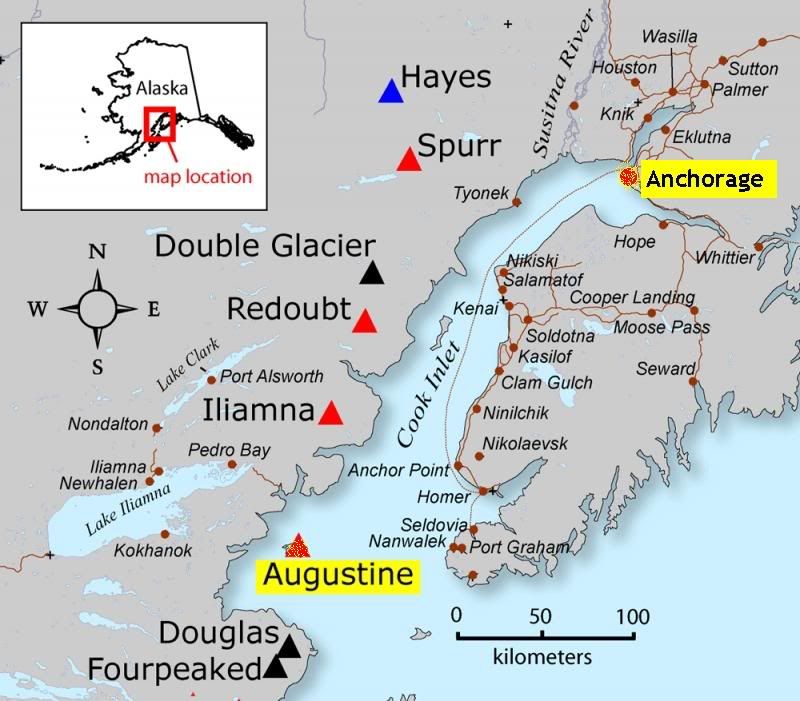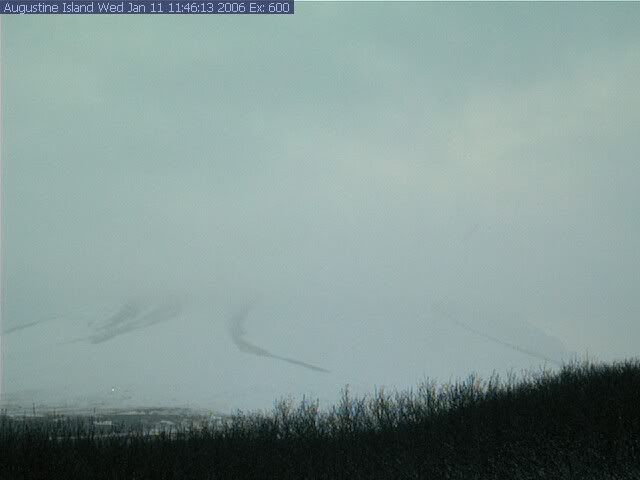For those not in Alaska or not up on current events...
Mount Augustine Volcano erupted early Wednesday, sending an ash plume an estimated 30,000 feet into the Alaska sky.
A pair of explosions at 4:44 a.m and 5:13 a.m. indicated the volcano probably had erupted, said geologist Jennifer Adleman of the Alaska Volcano Observatory said. Seismic activity has not continued since those explosions.
The plume advanced north but was expected to remain west of Anchorage, said Bob Hopkins, meteorologist in charge in the Anchorage office. A flight advisory was issued for pilots for an area 20 miles east and west of the volcano and about 50 miles north.
"Fortunately, it's not going to Anchorage this time," Hopkins said. The volcano is on an uninhabited island about 180 miles southwest of Anchorage and across Cook Inlet from the Kenai Peninsula. The volcano is about 75 miles southwest of Homer.

Winds are carrying an ash plume from the mountain north toward the Iniskin Peninsula on the west side of Cook Inlet, an area with little settlement.
But winds above 20,000 feet were moving east toward the Kenai Peninsula, meaning light ash could reach the Anchor Point area this morning.
The ash is not expected to reach Anchorage. The ash cloud appears to have low concentrations of ash, the National Weather Service said.
Those wind patterns are expected to hold for at least the next 24 hours, in case further eruptions take place, said National Weather Service meteorologist Neil Murakami.
The 4,134-foot volcano about 180 miles southwest of Anchorage last erupted in 1986. Ash from a 7-mile-high column drifted over Anchorage and kept flights out of the skies over Cook Inlet.
The explosions, with magnitude 2.6 seismic activity, occurred at 4:44 a.m. Alaska Standard Time, and the observatory upgraded the level of concern from orange to red, meaning a significant eruption was occurring or an explosive eruption was expected at any time.
Augustine had been rumbling since November, and seismic measurements picked up around 4 p.m. Tuesday. At 9:05 p.m., the observatory had upgraded the level of concern from yellow, or restless, to orange, meaning an eruption could occur at any time.
Further eruptions could take place at any time, U.S. Geological Survey scientists at the Alaska Volcano Observatory said.

A pair of explosions at 4:44 a.m and 5:13 a.m. indicated the volcano probably had erupted, said geologist Jennifer Adleman of the Alaska Volcano Observatory said. Seismic activity has not continued since those explosions.
The plume advanced north but was expected to remain west of Anchorage, said Bob Hopkins, meteorologist in charge in the Anchorage office. A flight advisory was issued for pilots for an area 20 miles east and west of the volcano and about 50 miles north.
"Fortunately, it's not going to Anchorage this time," Hopkins said. The volcano is on an uninhabited island about 180 miles southwest of Anchorage and across Cook Inlet from the Kenai Peninsula. The volcano is about 75 miles southwest of Homer.

Winds are carrying an ash plume from the mountain north toward the Iniskin Peninsula on the west side of Cook Inlet, an area with little settlement.
But winds above 20,000 feet were moving east toward the Kenai Peninsula, meaning light ash could reach the Anchor Point area this morning.
The ash is not expected to reach Anchorage. The ash cloud appears to have low concentrations of ash, the National Weather Service said.
Those wind patterns are expected to hold for at least the next 24 hours, in case further eruptions take place, said National Weather Service meteorologist Neil Murakami.
The 4,134-foot volcano about 180 miles southwest of Anchorage last erupted in 1986. Ash from a 7-mile-high column drifted over Anchorage and kept flights out of the skies over Cook Inlet.
The explosions, with magnitude 2.6 seismic activity, occurred at 4:44 a.m. Alaska Standard Time, and the observatory upgraded the level of concern from orange to red, meaning a significant eruption was occurring or an explosive eruption was expected at any time.
Augustine had been rumbling since November, and seismic measurements picked up around 4 p.m. Tuesday. At 9:05 p.m., the observatory had upgraded the level of concern from yellow, or restless, to orange, meaning an eruption could occur at any time.
Further eruptions could take place at any time, U.S. Geological Survey scientists at the Alaska Volcano Observatory said.
